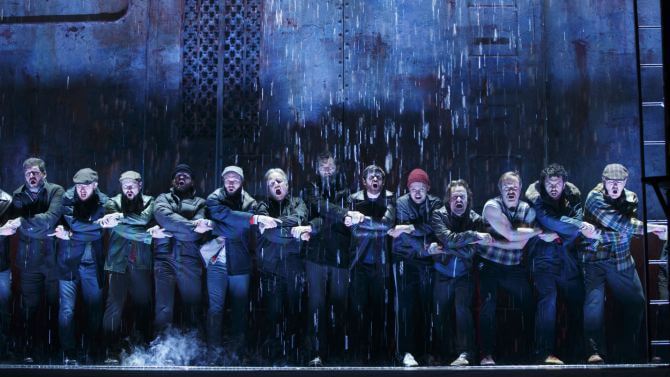We’ve been listening to the music from “The Last Ship” since seeing it last week, just before it opened on Oct. 26. The score offers just the right blend of Sting and Broadway to satisfy fans of both, while telling a fairly succinct narrative through songs that, for the most part, also hold up independently. The downside is that the show, directed by Joe Mantello, might as well be a staged concept album. It’s buoyed by the compositions (and some outstanding, on-point choreography by Steven Hoggett), but missing the focus and character development required of a sturdier theater piece. There are perhaps five too many numbers, which means that the show sails past the two-and-a-half-hour mark — and simply doesn’t leave enough substance in its wake. Plot: ‘The Last Ship’
We’re first introduced to young Gideon (Collin Kelly-Sordelet) and Meg (Dawn Cantwell), who are madly in love but feel suffocated in their small seaside town. When Gideon’s father is injured and has to retire, the teen decides to jump ship rather than follow in his old man’s shoes (literally — hand-me-down work boots). After 15 years, older Gideon (Michael Esper) is back from his Homeric journey. He hasn’t amounted to much, and he finds that life has moved on without him. And then there’s adult Meg (the searing Rachel Tucker): Despite her bureaucratic new beau (Aaron Lazar) and son (also Kelly-Sordelet), Gideon decides she’s the only thing that ever made sense — or, at least, she’s a suitable stand-in for the approval that he really craves — so he must have her back. While we were watching the first act, a man in the row behind us called out loudly, “If she picks Gideon, I’m leaving. He’s a d—bag.” True, it’s a bastardly thing to try to break up a family because you called “dibs” on it a few decades ago. But Meg takes a long time to make up her own mind, which makes the audience wonder if we’re supposed to root for that “d—bag” — especially since we’re so conditioned to seeing steamy romance triumph over settling down. Plus, the play is loosely based on the life of producer/songwriter Sting, and you feel an undertow of built-in empathy for his likeness in Gideon. All hands are on deck for the second plot, which is full of soul and really fights to be the prominent tale. The shipyard, the economic hub of the seaside town, is being closed. It’s cheaper and faster to have ships made overseas by machines rather than men. But the locals won’t go quietly obsolete; instead, they occupy the shipyard and go about building one last ship — the best ship, a ship for no one but themselves, that they’ll take out to sea. What will become of their families, their livelihoods and their town in the meantime? It’s something they’ll apparently face when they return. This storyline tackles all-too-real economic and employment issues, as well as trickier threads on identity, ego and machismo, with wrenching honesty and just enough fantasy to keep it from utter bleakness. It questions whether pride, tradition and especially faith can tide communities over in the face of these hardships. But that’s all a bit heavy, so we have the lopsided love triangle to fall back on and plenty of rousing songs to get us from one rocky plot foothold to the next until we reach an uplifting ending. No, it can never be a true resolution, since no one knows what tomorrow will bring — but it shows that the townspeople are strong enough to stand by one another until they see it through. Summary
With a leaner load and more even keel, “The Last Ship” would be an outstanding example of musical theater for the 21st century. Instead, its legacy will be its soundtrack — nostalgic for the lost art of community, celebrating the idea that it can be rebuilt.
All aboard ‘The Last Ship’

Provided

















